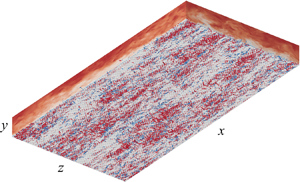Article contents
Outer-layer similarity and energy transfer in a rough-wall turbulent channel flow
Published online by Cambridge University Press: 04 August 2023
Abstract

Direct numerical simulations (DNSs) are performed to investigate the roughness effects on the statistical properties and the large-scale coherent structures in the turbulent channel flow over three-dimensional sinusoidal rough walls. The outer-layer similarities of mean streamwise velocity and Reynolds stresses are examined by systematically varying the roughness Reynolds number  $k^{+}$ and the ratio of the roughness height to the half-channel height
$k^{+}$ and the ratio of the roughness height to the half-channel height  $k / \delta$. The energy transfer mechanism of turbulent motions in the presence of roughness elements with different sizes is explored through spectral analysis of the transport equation of the two-point velocity correlation and the scale-energy path display of the generalized Kolmogorov equation. The results show that, with increasing
$k / \delta$. The energy transfer mechanism of turbulent motions in the presence of roughness elements with different sizes is explored through spectral analysis of the transport equation of the two-point velocity correlation and the scale-energy path display of the generalized Kolmogorov equation. The results show that, with increasing  $k^+$, the downward shift of the mean streamwise velocity profile in the logarithmic region increases and the peak intensities of turbulent Reynolds stresses decrease. At an intermediate Reynolds number (
$k^+$, the downward shift of the mean streamwise velocity profile in the logarithmic region increases and the peak intensities of turbulent Reynolds stresses decrease. At an intermediate Reynolds number ( $Re_{\tau }= 1080$), the length scale and intensity of the large-scale coherent structures increase for a small roughness (
$Re_{\tau }= 1080$), the length scale and intensity of the large-scale coherent structures increase for a small roughness ( $k^{+}=10$), which leads to failure of the outer-layer similarity in rough-wall turbulence, and decrease for a large roughness (
$k^{+}=10$), which leads to failure of the outer-layer similarity in rough-wall turbulence, and decrease for a large roughness ( $k^{+}=60$), as compared with the smooth-wall case. The existence of the small roughness (
$k^{+}=60$), as compared with the smooth-wall case. The existence of the small roughness ( $k^{+}=10$) enhances the mechanism of inverse energy cascade from the inner-layer small-scale structures to the outer-layer large-scale structures. Correspondingly, the self-sustaining processes of the outer-layer large-scale coherent structures, including turbulent production, interscale transport, pressure transport and spatial turbulent transport, are all enhanced, whereas the large roughness (
$k^{+}=10$) enhances the mechanism of inverse energy cascade from the inner-layer small-scale structures to the outer-layer large-scale structures. Correspondingly, the self-sustaining processes of the outer-layer large-scale coherent structures, including turbulent production, interscale transport, pressure transport and spatial turbulent transport, are all enhanced, whereas the large roughness ( $k^{+}=60$) weakens the energy transfer between the inner and outer regions.
$k^{+}=60$) weakens the energy transfer between the inner and outer regions.
JFM classification
- Type
- JFM Papers
- Information
- Copyright
- © The Author(s), 2023. Published by Cambridge University Press
References
- 2
- Cited by





